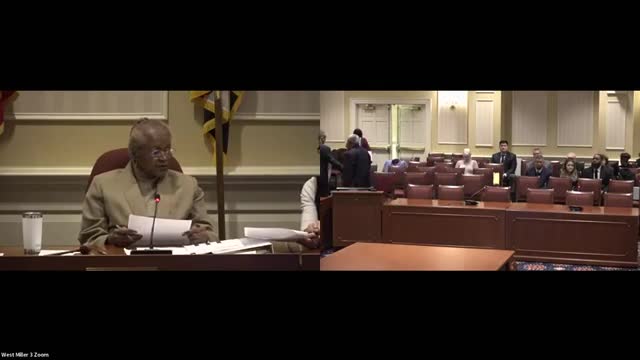Maryland college presidents advocate for Sellinger funding during General Assembly budget hearings
February 23, 2024 | Education, Business and Administration Subcommittee, Budget and Taxation Committee, SENATE, SENATE, Committees, Legislative, Maryland

This article was created by AI summarizing key points discussed. AI makes mistakes, so for full details and context, please refer to the video of the full meeting. Please report any errors so we can fix them. Report an error »

On February 23, 2024, the Maryland Legislature's EBA Committee convened to discuss critical funding issues affecting independent higher education institutions in the state. The meeting highlighted the significant role of the Sellinger program, which provides financial support to nonprofit colleges and universities, and the potential impact of proposed budget cuts.
Nat Powers, representing the Maryland State Independent College and University Association (MICUA), emphasized the historical importance of linking funding for nonprofit institutions to public education. He argued that this collaborative funding model has been essential for creating a skilled workforce in Maryland. However, he expressed concern that the proposed nearly 50% cut to the Sellinger program undermines this partnership and could jeopardize the state's goal of producing 55% of the necessary degrees.
Powers pointed out that the current funding levels are insufficient to meet educational goals, questioning the rationale behind setting new targets without adequate financial support. He urged the committee to consider the long-term benefits of maintaining the Sellinger program, which he described as a "tremendous return on investment" for the state.
Elliot Hirschman, President of Stevenson University, reinforced these points by highlighting that the Sellinger program, despite representing only 4% of higher education funding in Maryland, contributes significantly to the state's degree production—27% of undergraduate and 47% of graduate degrees. He noted that Maryland is losing students to other states, which are increasingly investing in independent higher education to enhance workforce competitiveness.
Mary Lou Yam, President of Notre Dame of Maryland University, shared her institution's commitment to serving a diverse student population and its role in preparing teachers and healthcare professionals. She warned that the proposed cuts could severely impact financial aid for students, particularly those from low-income backgrounds, and hinder the state's educational goals.
Tim Trainor, President of Mount Saint Mary's University, also spoke to the transformative impact of the Sellinger program on his institution, which has become a major employer in its region and expanded access to education for diverse populations.
The overarching theme of the meeting was a call for the Maryland Legislature to reconsider the proposed cuts to the Sellinger program. The leaders of independent colleges and universities urged the committee to adopt a fair and equitable distribution of funding that recognizes the vital contributions these institutions make to the state's economy and workforce development.
As the committee deliberates on the FY 25 budget, the discussions from this meeting underscore the critical intersection of education funding and workforce needs in Maryland. The outcomes of these discussions will likely have lasting implications for the state's higher education landscape and its ability to retain and attract talent.
Nat Powers, representing the Maryland State Independent College and University Association (MICUA), emphasized the historical importance of linking funding for nonprofit institutions to public education. He argued that this collaborative funding model has been essential for creating a skilled workforce in Maryland. However, he expressed concern that the proposed nearly 50% cut to the Sellinger program undermines this partnership and could jeopardize the state's goal of producing 55% of the necessary degrees.
Powers pointed out that the current funding levels are insufficient to meet educational goals, questioning the rationale behind setting new targets without adequate financial support. He urged the committee to consider the long-term benefits of maintaining the Sellinger program, which he described as a "tremendous return on investment" for the state.
Elliot Hirschman, President of Stevenson University, reinforced these points by highlighting that the Sellinger program, despite representing only 4% of higher education funding in Maryland, contributes significantly to the state's degree production—27% of undergraduate and 47% of graduate degrees. He noted that Maryland is losing students to other states, which are increasingly investing in independent higher education to enhance workforce competitiveness.
Mary Lou Yam, President of Notre Dame of Maryland University, shared her institution's commitment to serving a diverse student population and its role in preparing teachers and healthcare professionals. She warned that the proposed cuts could severely impact financial aid for students, particularly those from low-income backgrounds, and hinder the state's educational goals.
Tim Trainor, President of Mount Saint Mary's University, also spoke to the transformative impact of the Sellinger program on his institution, which has become a major employer in its region and expanded access to education for diverse populations.
The overarching theme of the meeting was a call for the Maryland Legislature to reconsider the proposed cuts to the Sellinger program. The leaders of independent colleges and universities urged the committee to adopt a fair and equitable distribution of funding that recognizes the vital contributions these institutions make to the state's economy and workforce development.
As the committee deliberates on the FY 25 budget, the discussions from this meeting underscore the critical intersection of education funding and workforce needs in Maryland. The outcomes of these discussions will likely have lasting implications for the state's higher education landscape and its ability to retain and attract talent.
View full meeting
This article is based on a recent meeting—watch the full video and explore the complete transcript for deeper insights into the discussion.
View full meeting
